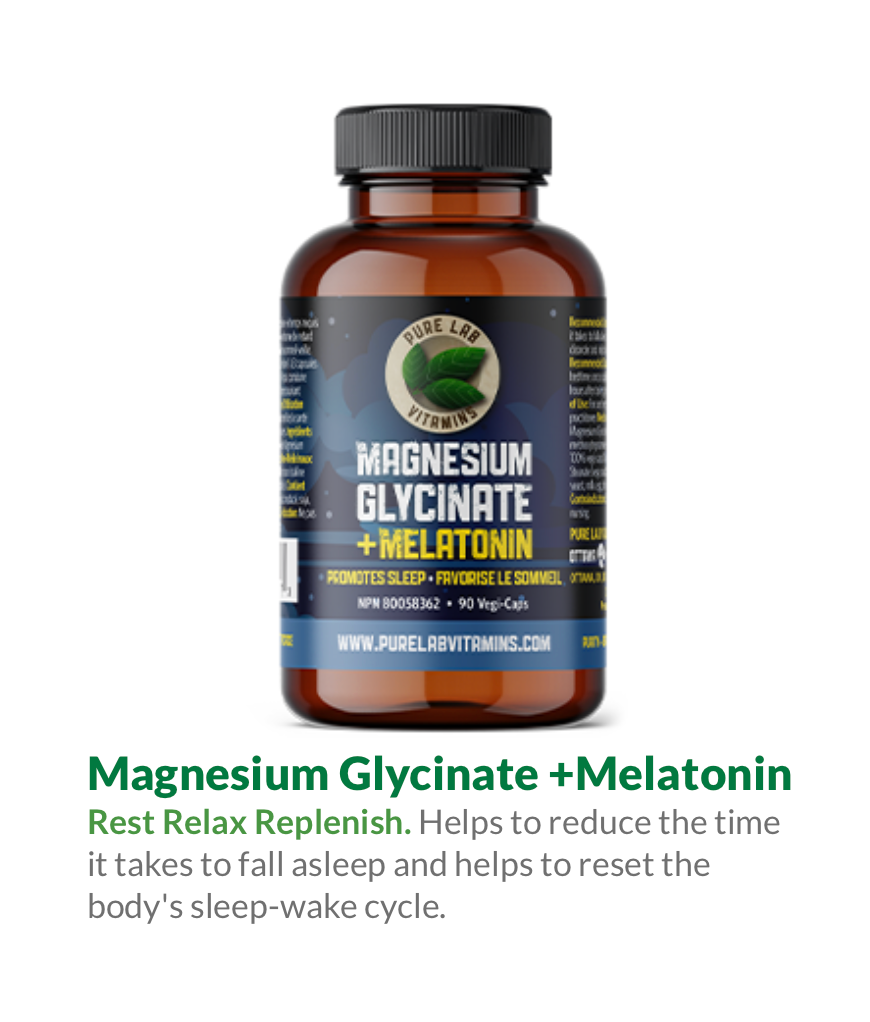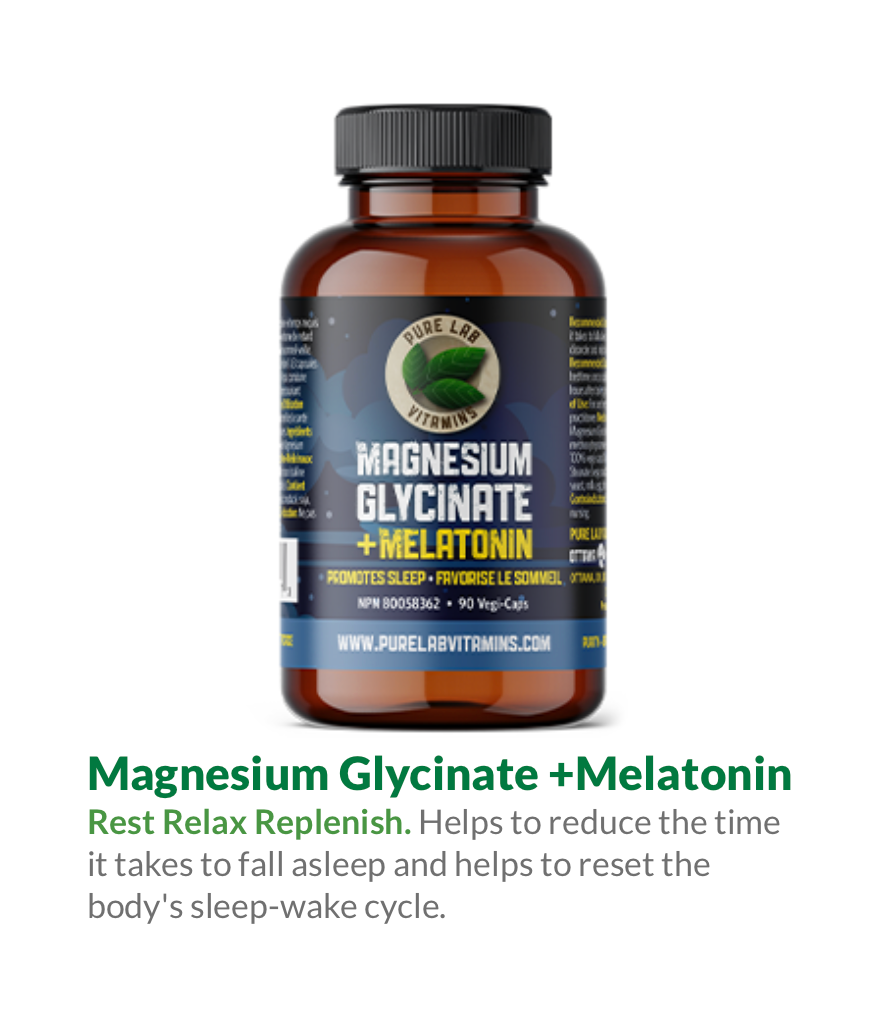Pure Lab Vitamins
Magnesium Glycinate + Melatonin 90 Vegi-Caps
Magnesium Glycinate + Melatonin 90 Vegi-Caps
Couldn't load pickup availability
"REST, RELAX, REPLENISH"
~Promotes Sleep~
About Magnesium Glycinate +Melatonin
Melatonin is a natural hormone made by your body's pineal (pih-knee-uhl) gland, a pea-sized gland located right in the middle of the brain, next to the Hypothalamus.
During the day the pineal is inactive.
When the sun goes down and darkness occurs, the pineal gland is "turned on" by the so-called Suprachiasmatic Nucleus (SCN) and begins to actively produce melatonin, which is released into the blood.
Usually, this occurs at around 9 pm.
As a result, melatonin levels in the blood rise sharply and you begin to feel less alert, sleep becomes more inviting.
Melatonin levels stay elevated for about 12 hours - all through the night - before the light of a new day makes them fall back to low daytime levels by about 9 am.
Magnesium and melatonin work together.
Magnesium helps the body’s melatonin production. Think of magnesium as the body’s relaxer - of muscle and mind.
Magnesium suppresses the release of stimulating catecholamines.
This means magnesium deficiency leads to more stimulation = less relaxation.
Dosage recommendations (scroll down)
Common conditions that could benefit from Magnesium Glycinate +Melatonin use:
Insomnia / Shift work / Jet lag
Antioxidant / Radical Scavenger
ADD/ADHD
Premenstrual Syndrome (PMS)
Migraines
Autism
Read more about how Melatonin and Magnesium Glycinate help in the conditions under Research.
Dosage recommendations:
Dosage of Magnesium Glycinate +Melatonin can be tailored to your personal needs.
Some individuals might feel a bit foggy, when taking 2 or 3 capsules,
so they could just try 1 capsule at night.
If you have problems falling asleep, take 1 to 3 capsules about an hour before bedtime, so that you have it working at full activity, by the time you are going to bed.
If you have problems staying asleep, take 1 to 3 caps as late as possible, When the head hits the pillow. This way it will last longer through the night.
If you have problems falling and staying asleep, you could take 1 capsule about one hour before bedtime, plus two more capsules right when you go to bed.
Sweet dreams!
Ingredients
Medicinal Ingredients (per capsule): Magnesium (Magnesium Glycinate) 100 mg, Melatonin 3 mg.
Non-Medical Ingredients: 100% vegetarian capsule, Cellulose, Magnesium Stearate (veg. source), Silicon Dioxide.
Contains no: sugar, salt, yeast, wheat, gluten, corn, milk, egg, shellfish or preservatives.
Choose Magnesium Nighttime by Pure Lab Vitamins!
Pure and certified Gluten Free.s
Research
Pure Lab Vitamins Magnesium Glycinate +Melatonin caps are NHPD approved for the following claims:
• Helps increase the total sleep time (aspect of sleep quality) in people suffering from sleep restriction or
altered sleep schedule e.g. shift work and jet lag
• Helps relieve the daytime fatigue associated with jet lag
• Helps to reduce the time it takes to fall asleep (sleep onset latency aspect of sleep quality) in people
with delayed sleep phase syndrome
• Helps re-set the body's sleep-wake cycle (aspect of the circadian rhythm)
Conditons:
Insomnia, Shift work, Jet lag
Antioxidant and Free Radical Scavenger
ADD/ADHD
Premenstrual Syndrome (PMS)
Migraines
Insomnia, Shift work, Jet lag:
Melatonin helps regulate the circadian rhythm, the day-night cycle.
In the body it is naturally synthesized from the amino acid tryptophan and its production is influenced by information received from the retina in the eye, about the daily patterns of light and darkness.
Generally, the production of melatonin is inhibited by light and permitted by darkness. For this reason melatonin has been called: the hormone of darkness.
The secretion of melatonin peaks in the middle of the night and gradually falls during the second half of the night. Even low light levels can diminish melatonin production to some extent.
Light emitted from todays omni-present electronic screens can alter these natural patterns and influence the circadian rhythm.
There is evidence that circadian rhythms in humans may be disrupted by exposure to electromagnetic fields from power lines, appliances, screens and cellular phones.[6] Altered neural function from exposure to extremely low frequency fields (found near high-voltage power lines) and suppressed melatonin levels have been reported.[7]
Melatonin increases the amount of sleep in people after working night shifts.[8]
Melatonin has been used since the 1970's to reduce the effects of jet lag, by promoting the necessary re-set of the body's sleep-wake phase. Proper dose timing is crucial, however, it can otherwise prolong adaption.[9]
Magnesium and melatonin work together.
Magnesium helps in the body’s produce melatonin, but also think of magnesium as the body’s relaxer - of muscle and mind.
Magnesium suppresses the release of stimulating catecholamines.
This means magnesium deficiency leads to more stimulation = less relaxation.
You will find more information in the Research Tab of our Magnesium Glycinate product info.
Antioxidant and Free Radical Scavenger:
Besides its function as synchronizer of the biological clock, melatonin is a powerful free-radical scavenger and wide-spectrum antioxidant as discovered in 1993.[1][2]
Melatonin is an antioxidant that can easily cross cell membranes[3] and the blood–brain barrier.[4]
Melatonin has been proven to be twice as active as vitamin E, believed to be the most effective lipophilic antioxidant.[5]
Also different from other classic antioxidants, such as vitamin C and vitamin E, melatonin has amphiphilic properties, which means it is active in fatty tissues and watery systems, like blood and lymph.
ADD and ADHD:
According to a 2009 review, published in the American Academy of Pediatrics’ Journal: “Pediatrics in Review,” roughly 29 percent of children with ADHD who receive ongoing treatment with stimulant medication have significant sleep disturbances.
Children who take the ADHD medication methylphenidate have a particularly high rate of sleep problems, and fully 54 to 64 percent of these children experience symptoms of insomnia.
And a growing number of physicians prescribe melatonin at therapeutic doses to help these children maintain a healthy sleep rhythm.
Short and longterm studies.[10,11,12,13] showed Melatonin to be safe and to significantly improve sleep onset and sleep duration.
Sleep hygiene is most important.
This includes a consistent routine, a dark and quiet sleep space, avoiding hunger (and eating) prior to bedtime, relaxation techniques before bed, strict avoidance of television, computers, handheld devices and video games, and encouraging reading prior to bedtime.
Premenstrual Syndrome - PMS
Premenstrual Dysphoric Disorder - PMDD
A new study by Douglas Mental Health University Institute, Lachine, Qc. shows altered body rhythms of the hormone melatonin in Premenstrual dysphoric disorder (PMDD) women with insomnia. The main finding was that compared to healthy controls, PMDD women had significantly decreased melatonin secretion levels during the night-time hours.[14]
This finding may help explain some of the sleep disruptions experienced by women with PMDD, also known as premenstrual syndrome.
Restless Leg Syndrome (RLS) often goes hand in hand with PMS symptoms. A condition that benefits significantly from the Magnesium Glycinate portion in our Magnesium Nighttime formulation.
Migraines
The beneficial effects of therapeutic dosing of Magnesium Glycinate for migraine sufferers have been discussed in detail in the research tab of our regular Magnesium Glycinate product.
We also have quite a few testimonials from Migraine sufferers on our site.
But many migraineurs are susceptible to various environmental triggers that influence the secretion of melatonin from the pineal gland. [15] Melatonin levels have been found to be decreased in both migraine and cluster headaches sufferers.
Melatonin mechanisms are related to headache pathophysiology in many ways, including its anti-inflammatory effect, toxic free radical scavenging, reduction of pro-inflammatory cytokine upregulation, nitric oxide synthase activity and dopamine release inhibition, membrane stabilisation, GABA and opioid analgesia potentitation, glutamate neurotoxicity protection, neurovascular regulation, 5-HT modulation.[16]
Interestingly, melatonin has also been studied as a treatment for other migraine co-morbidities, such as irritable-bowel syndrome. A paper published in 2005 showed that 88% of subjects reported mild-to-excellent improvement in IBS symptoms [17] when taking supplemental melatonin. This makes sense, given the strong correlation between migraine, abdominal migraine, infantile colic and irritable bowel syndrome [18].
Next to getting a good nights sleep,
the benefits from melatonin supplementation in these conditions seem promising and worth a try.
Studies:
1: Tan DX, Chen LD, Poeggeler B, Manchester LC, Reiter RJ (1993). "Melatonin: a potent, endogenous hydroxyl radical scavenger". Endocrine J. 1: 57–60.
2: Poeggeler B, Saarela S, Reiter RJ, Tan DX, Chen LD, Manchester LC, Barlow-Walden LR (November 1994). "Melatonin – a highly potent endogenous radical scavenger and electron donor: new aspects of the oxidation chemistry of this indole accessed in vitro". Ann. N. Y. Acad. Sci. 738: 419–20.
3: Pohanka M (2011). "Alzheimer´s disease and related neurodegenerative disorders: implication and counteracting of melatonin" (PDF). Journal of Applied Biomedicine 9 (4): 185–196.
4: Reiter RJ, Manchester LC, Tan DX (September 2010). "Neurotoxins: free radical mechanisms and melatonin protection". Curr Neuropharmacol 8 (3): 194–210.
5: Pieri C, Marra M, Moroni F, Recchioni R, Marcheselli F (1994). "Melatonin: a peroxyl radical scavenger more effective than vitamin E". Life Sci. 55 (15): PL271–6.
6: Burch JB, Reif JS, Noonan CW, et al. Melatonin metabolite excretion among cellular telephone users. Int J Radiat Biol 2002;78:1029-1036.
7: Karasek M, Lerchl A. Melatonin and magnetic fields. Neuro Endocrinol Lett 2002;23:S84-S87.
8: Liira, J; Verbeek, JH; Costa, G; Driscoll, TR; Sallinen, M; Isotalo, LK; Ruotsalainen, JH (12 August 2014). "Pharmacological interventions for sleepiness and sleep disturbances caused by shift work.". The Cochrane database of systematic reviews 8: CD009776. PMID 25113164.
9: Herxheimer A1, Petrie KJ. Melatonin for the prevention and treatment of jet lag. Cochrane Database Syst Rev. 2002;(2):CD001520. PMID 12076414
10: van der Heijden KB, Smits MG, Someren EJ et al. (2007) Effect of melatonin on sleep,
behavior, and cognition in ADHD and chronic sleep-onset insomnia. Journal of the American
Academy of Child and Adolescent Psychiatry 46: 233–41
11: Weiss MD, Wasdell MB, Bomben MM et al. (2006) Sleep hygiene and melatonin treatment for:
children and adolescents with ADHD and initial insomnia. Journal of the American Academy of
Child and Adolescent Psychiatry 45: 512–9
12: Hoebert M, van der Heijden KB, van Geijlswijk IM et al. (2009) Long-term follow-up of
melatonin treatment in children with ADHD and chronic sleep onset insomnia. Journal of Pineal
Research 47: 1–7
13: Sanchez-Barcelo E, Mediavilla M, Reiter R. Clinical uses of melatonin in pediatrics. Int J Pediatrics. 2011; 892624
14: Ari Shechter, Paul Lespérance, N. M. K. Ng Ying Kin, Diane B. Boivin. Pilot Investigation of the Circadian Plasma Melatonin Rhythm across the Menstrual Cycle in a Small Group of Women with Premenstrual Dysphoric Disorder. PLoS ONE, 2012; 7 (12): e51929 DOI: 10.1371
15: Vogler B1, Rapoport AM, Tepper SJ, Role of melatonin in the pathophysiology of migraine: implications for treatment.CNS Drugs. 2006;20(5):343-50.
16: Peres MF, Melatonin, the pineal gland and their implications for headache disorders. Cephalalgia. 2005 Jun;25(6):403-11.
17: Lu, WZ, Gwee, KA, Moochhalla, S, Ho, KY (2005). Melatonin improves bowel symptoms in female patients with irritable bowel syndrome: a double-blind placebo-controlled study. Alimentary Pharmacology and Therapeutics, 22(10), 927–934. doi:10.1111/j.1365-2036.2005.02673.x
18: Romanello, S., Spiri, D., Marcuzzi, E., Zanin, A., Boizeau, P., Riviere, S., et al. (2013). Association between childhood migraine and history of infantile colic. JAMA, 309(15), 1607–1612. doi:10.1001/jama.2013.747
Share


